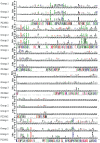Mining bacterial genomes for novel arylesterase activity
- PMID: 21255363
- PMCID: PMC3815341
- DOI: 10.1111/j.1751-7915.2010.00185.x
Mining bacterial genomes for novel arylesterase activity
Abstract
One hundred and seventy-one genes encoding potential esterases from 11 bacterial genomes were cloned and overexpressed in Escherichia coli; 74 of the clones produced soluble proteins. All 74 soluble proteins were purified and screened for esterase activity; 36 proteins showed carboxyl esterase activity on short-chain esters, 17 demonstrated arylesterase activity, while 38 proteins did not exhibit any activity towards the test substrates. Esterases from Rhodopseudomonas palustris (RpEST-1, RpEST-2 and RpEST-3), Pseudomonas putida (PpEST-1, PpEST-2 and PpEST-3), Pseudomonas aeruginosa (PaEST-1) and Streptomyces avermitilis (SavEST-1) were selected for detailed biochemical characterization. All of the enzymes showed optimal activity at neutral or alkaline pH, and the half-life of each enzyme at 50°C ranged from < 5 min to over 5 h. PpEST-3, RpEST-1 and RpEST-2 demonstrated the highest specific activity with pNP-esters; these enzymes were also among the most stable at 50°C and in the presence of detergents, polar and non-polar organic solvents, and imidazolium ionic liquids. Accordingly, these enzymes are particularly interesting targets for subsequent application trials. Finally, biochemical and bioinformatic analyses were compared to reveal sequence features that could be correlated to enzymes with arylesterase activity, facilitating subsequent searches for new esterases in microbial genome sequences.
© 2010 The Authors. Journal compilation © 2010 Society for Applied Microbiology and Blackwell Publishing Ltd.
Figures



References
-
- Argos P., Rossman M.G., Grau U.M., Zuber H., Frank G., Tratschin J.D. Thermal stability and protein structure. Biochemistry. 1979;18:5698–5703. - PubMed
-
- Bornscheuer U.T. Microbial carboxyl esterases: classification, properties and application in biocatalysis. FEMS Microbiol Rev. 2002;26:73–81. - PubMed
-
- Chalas J., Claise C., Edeas M., Messaoudi C., Vergnes L., Abella A., Lindenbaum A. Effect of ethyl esterification of phenolic acids on low‐density lipoprotein oxidation. Biomed Pharmacother. 2001;55:54–60. - PubMed
Publication types
MeSH terms
Substances
LinkOut - more resources
Full Text Sources
Miscellaneous

